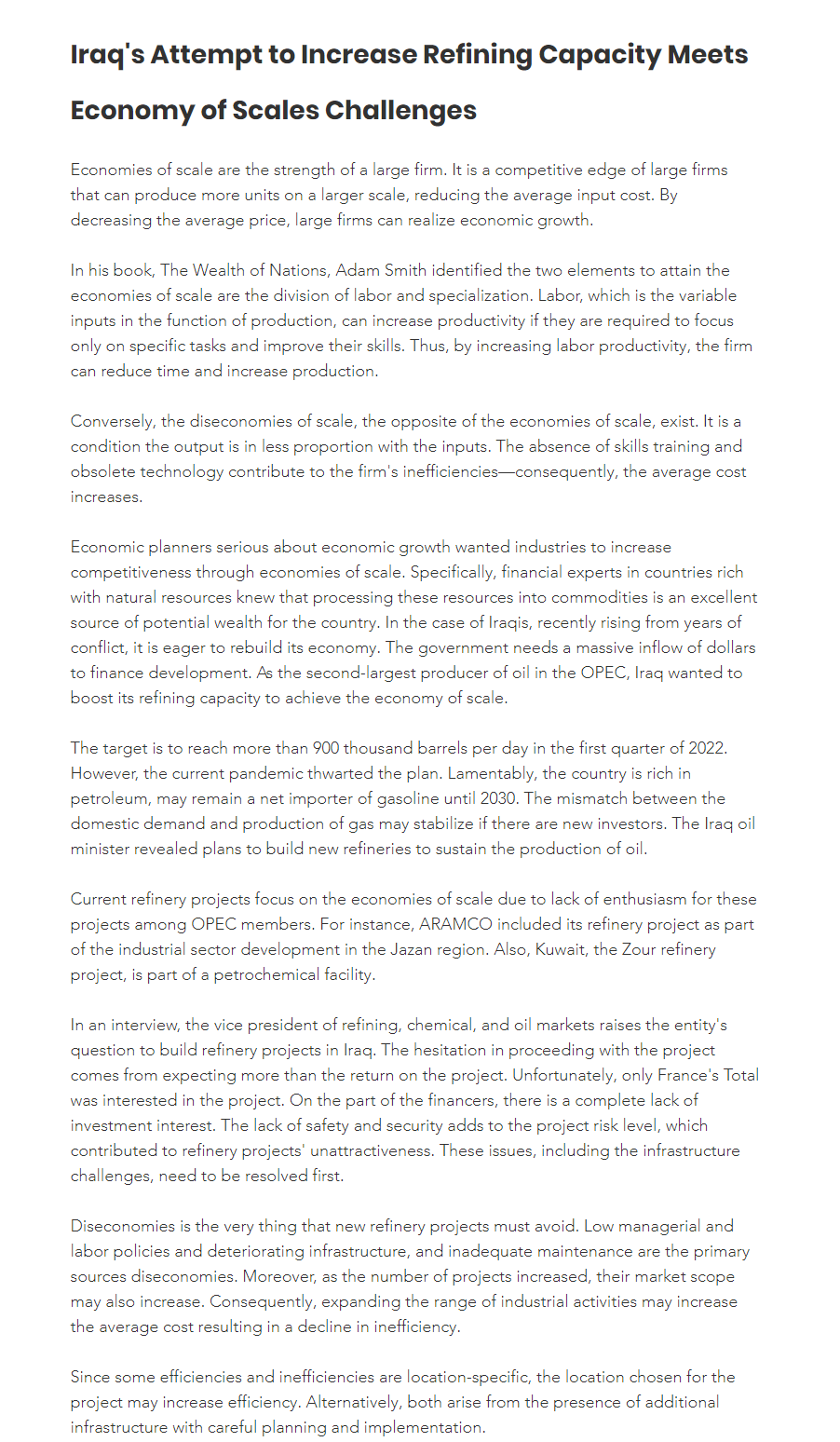The article discussed the potential of Iraq as a major oil supplier. Draw a hypothetical demand and supply of Iraq petroleum before and after all their oil refinery projects were established. Thus you will depict two equilibrium prices. Explain the movement of prices in the market by identifying the factors that may cause these shifts
The article discussed the potential of Iraq as a major oil supplier. Draw a hypothetical demand and supply of Iraq petroleum before and after all their oil refinery projects were established. Thus you will depict two equilibrium prices. Explain the movement of prices in the market by identifying the factors that may cause these shifts
Chapter9: Production Functions
Section: Chapter Questions
Problem 9.2P
Related questions
Question
100%
The article discussed the potential of Iraq as a major oil supplier. Draw a hypothetical

Transcribed Image Text:Iraq's Attempt to Increase Refining Capacity Meets
Economy of Scales Challenges
Economies of scale are the strength of a large firm. It is a competitive edge of large firms
that can produce more units on a larger scale, reducing the average input cost. By
decreasing the average price, large firms can realize economic growth.
In his book, The Wealth of Nations, Adam Smith identified the two elements to attain the
economies of scale are the division of labor and specialization. Labor, which is the variable
inputs in the function of production, can increase productivity if they are required to focus
only on specific tasks and improve their skills. Thus, by increasing labor productivity, the firm
can reduce time and increase production.
Conversely, the diseconomies of scale, the opposite of the economies of scale, exist. It is a
condition the output is in less proportion with the inputs. The absence of skills training and
obsolete technology contribute to the firm's inefficiencies-consequently, the average cost
increases.
Economic planners serious about economic growth wanted industries to increase
competitiveness through economies of scale. Specifically, financial experts in countries rich
with natural resources knew that processing these resources into commodities is an excellent
source of potential wealth for the country. In the case of Iraqis, recently rising from years of
conflict, it is eager to rebuild its economy. The government needs a massive inflow of dollars
to finance development. As the second-largest producer of oil in the OPEC, Iraq wanted to
boost its refining capacity to achieve the economy of scale.
The target is to reach more than 900 thousand barrels per day in the first quarter of 2022.
However, the current pandemic thwarted the plan. Lamentably, the country is rich in
petroleum, may remain a net importer of gasoline until 2030. The mismatch between the
domestic demand and production of gas may stabilize if there are new investors. The Iraq oil
minister revealed plans to build new refineries to sustain the production of oil.
Current refinery projects focus on the economies of scale due to lack of enthusiasm for these
projects among OPEC members. For instance, ARAMCO included its refinery project as part
of the industrial sector development in the Jazan region. Also, Kuwait, the Zour refinery
project, is part of a petrochemical facility.
In an interview, the vice president of refining, chemical, and oil markets raises the entity's
question to build refinery projects in Iraq. The hesitation in proceeding with the project
comes from expecting more than the return on the project. Unfortunately, only France's Total
was interested in the project. On the part of the financers, there is a complete lack of
investment interest. The lack of safety and security adds to the project risk level, which
contributed to refinery projects' unattractiveness. These issues, including the infrastructure
challenges, need to be resolved first.
Diseconomies is the very thing that new refinery projects must avoid. Low managerial and
labor policies and deteriorating infrastructure, and inadequate maintenance are the primary
sources diseconomies. Moreover, as the number of projects increased, their market scope
may also increase. Consequently, expanding the range of industrial activities may increase
the average cost resulting in a decline in inefficiency.
Since some efficiencies and inefficiencies are location-specific, the location chosen for the
project may increase efficiency. Alternatively, both arise from the presence of additional
infrastructure with careful planning and implementation.
Expert Solution
This question has been solved!
Explore an expertly crafted, step-by-step solution for a thorough understanding of key concepts.
Step by step
Solved in 2 steps with 2 images

Knowledge Booster
Learn more about
Need a deep-dive on the concept behind this application? Look no further. Learn more about this topic, economics and related others by exploring similar questions and additional content below.Recommended textbooks for you


Principles of Economics 2e
Economics
ISBN:
9781947172364
Author:
Steven A. Greenlaw; David Shapiro
Publisher:
OpenStax



Principles of Economics 2e
Economics
ISBN:
9781947172364
Author:
Steven A. Greenlaw; David Shapiro
Publisher:
OpenStax


Exploring Economics
Economics
ISBN:
9781544336329
Author:
Robert L. Sexton
Publisher:
SAGE Publications, Inc

Microeconomics: Principles & Policy
Economics
ISBN:
9781337794992
Author:
William J. Baumol, Alan S. Blinder, John L. Solow
Publisher:
Cengage Learning
